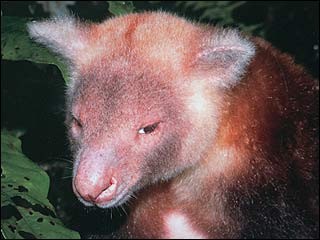
February 8, 2006
Do you know where the Foja Mountains are? Most people don’t.
And are there really "hundreds of new species" discovered?
Bruce Beehler of the U.S. organization Conservation International and Indonesian Institute of Sciences reportedly told the BBC: "It’s a beautiful, untouched, unpopulated forest. We found dozens, if not hundreds, of new species."
The attention to the new "Lost World" in Indonesia is all over the media, as mentioned earlier here on Cryptomundo. But what’s the reality behind the headlines?


Photographs of two rare but not "new" species – the long-beaked echidna and the golden-mantled tree kangeroo; Conservation International.
Not to put a damper on all the celebrations, but the Cryptomundo Truth Squad has to bring to your attention the following…
The Foja Mountains are in the former Irian Jaya, also known as Indonesian New Guinea, but today known as Papua. That’s on the western half of the island of New Guinea. This "Lost World" is not in Papua New Guinea (PNG), as some articles have reported. These mountains are near the north shore of Papua, not in Papua New Guinea.
Count up the number of new animals – whether birds, frogs, mammals. As opposed to claims of "hundreds" of species, will the final count even reach half a hundred? A close reading of the U.K.’s Independent notes, besides one new bird and two rediscoveries, "also found [were] more than 20 new species of frogs, four new butterflies, five new species of palm and many other plants yet to be classified." By a generous count, from the known new animals, that’s only a few more than 27 new animal species. Hardly hundreds. And no new mammal species. And I didn’t count the palms, of course, although I should have because, well, they didn’t say new "animal" species. But I bet that’s what you thought when you first read about the "lost world." Maybe they found hundreds of new insects and plants, yet to be named? 🙂
Some of the bird "rediscoveries" were made as long ago as 2003, some perhaps as long ago as 25 years ago. Some of the "new species" are just new species for Indonesia (e.g. golden-mantled tree kangeroo), which means they are being found in the western side of New Guinea for the first time, but are known from, yep, the eastern side of the island, in, you guessed it, Papua New Guinea. These are not "new species."
Look, I’m excited by this news. It is great we can add another "Lost World" to the growing list, which includes the one from the 1990s, on the border of Vietnam and Laos. But some realistic examinations of all this media hype needs to be thrown into the mix here.
About Loren Coleman
Loren Coleman is one of the world’s leading cryptozoologists, some say “the” leading living cryptozoologist. Certainly, he is acknowledged as the current living American researcher and writer who has most popularized cryptozoology in the late 20th and early 21st centuries.
Starting his fieldwork and investigations in 1960, after traveling and trekking extensively in pursuit of cryptozoological mysteries, Coleman began writing to share his experiences in 1969. An honorary member of Ivan T. Sanderson’s Society for the Investigation of the Unexplained in the 1970s, Coleman has been bestowed with similar honorary memberships of the North Idaho College Cryptozoology Club in 1983, and in subsequent years, that of the British Columbia Scientific Cryptozoology Club, CryptoSafari International, and other international organizations. He was also a Life Member and Benefactor of the International Society of Cryptozoology (now-defunct).
Loren Coleman’s daily blog, as a member of the Cryptomundo Team, served as an ongoing avenue of communication for the ever-growing body of cryptozoo news from 2005 through 2013. He returned as an infrequent contributor beginning Halloween week of 2015.
Coleman is the founder in 2003, and current director of the International Cryptozoology Museum in Portland, Maine.
Filed under Breaking News, Cryptotourism, CryptoZoo News, Cryptozoology, Evidence, Expedition Reports, Eyewitness Accounts, Forensic Science, Media Appearances, New Species